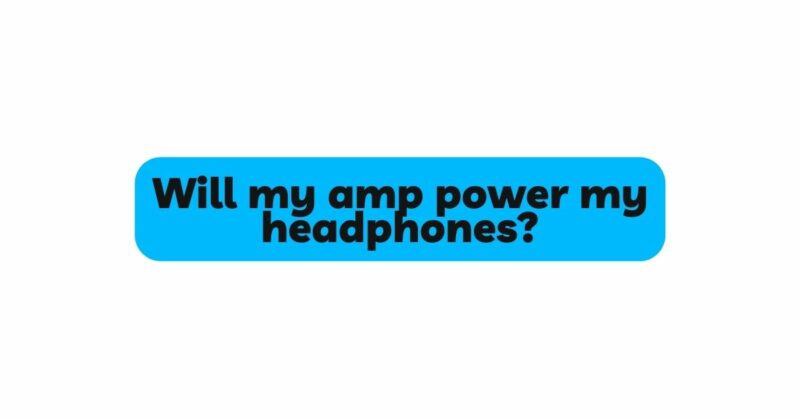For audio enthusiasts, headphones are an essential gateway to a world of immersive sound experiences. To unlock their full potential, the headphones must be powered adequately by the amplifier they are connected to. The question that often arises is, “Will my amp power my headphones?” In this comprehensive article, we will delve into the intricacies of amplifier power, impedance matching, sensitivity, and other crucial factors to help you determine if your amp is capable of driving your headphones optimally.
Understanding Amplifier Power and Headphone Impedance:
Amplifier power plays a vital role in determining how well your headphones will perform. Power is measured in watts (W) and represents the amount of electrical energy an amplifier can deliver to the headphones. Generally, the higher the amplifier’s power output, the better it can drive headphones, especially those with higher impedance or power requirements.
Headphone impedance, measured in ohms (Ω), represents the resistance the headphones offer to the electrical signal sent by the amplifier. Headphones with lower impedance, such as 16Ω or 32Ω, are easier to drive and require less power to achieve high volume levels. In contrast, headphones with higher impedance, such as 250Ω or 600Ω, demand more power to reach the same volume levels.
Matching Impedance for Optimal Performance:
To ensure your amplifier can power your headphones effectively, impedance matching is crucial. Matching impedance helps achieve a proper balance between the headphones and the amplifier, leading to better sound quality and preventing potential issues like distorted sound or damage to the headphones.
If the impedance of your headphones is significantly higher than the amplifier’s output impedance, it can result in a mismatch and hinder the headphones’ performance. Some amplifiers have adjustable output impedance or dedicated headphone outputs to cater to different impedance levels, providing an optimal match for various headphones.
Sensitivity and Efficiency:
Sensitivity is another essential aspect to consider when assessing amplifier capability for headphones. Sensitivity, measured in decibels per milliwatt (dB/mW), represents how efficiently the headphones convert electrical signals into sound. Headphones with higher sensitivity require less power to achieve the same volume level, making them more easily drivable by a broader range of amplifiers.
On the other hand, headphones with lower sensitivity demand more power to produce the same volume, and may require a more powerful amplifier to reach satisfactory listening levels.
Understanding Your Headphone’s Power Requirements:
Every pair of headphones comes with specifications that can help you determine the power they need. Manufacturers usually provide information about the headphone’s impedance and sensitivity in the product manual or on their website. This information is essential when matching the headphones to the appropriate amplifier.
To calculate the power requirements for your headphones, you can use the formula: Power (mW) = (Voltage²) / Impedance.
For example, if you have a pair of 32Ω headphones and your amplifier delivers 1V (1000mV) of output voltage, the power required to drive the headphones would be (1000mV)² / 32Ω = 31.25mW.
Checking Amplifier Specifications:
Before connecting your headphones to an amplifier, it’s essential to examine the amplifier’s specifications, especially the output power and output impedance. The output power should be sufficient to drive your headphones to the desired volume level without distortion or strain.
Amplifiers with dedicated headphone outputs are generally better equipped to handle a wide range of headphone impedances and sensitivities. Some amplifiers may also have multiple gain settings or headphone impedance switches to optimize performance for different types of headphones.
Portable Devices and Smartphone Amplifiers:
Many portable devices, such as smartphones, tablets, and digital audio players, come with built-in headphone amplifiers. While these built-in amplifiers are convenient for on-the-go listening, they may not have the same power output as dedicated headphone amplifiers or home stereo amplifiers.
If you find that your portable device doesn’t provide enough power to drive your headphones optimally, you can consider using external portable headphone amplifiers or DAC/amp combos to enhance the audio quality and achieve higher volume levels.
Tube Amplifiers and High-Impedance Headphones:
Tube amplifiers are renowned for their warm and smooth sound characteristics. They are often favored by audiophiles and music enthusiasts. However, not all tube amplifiers are suitable for driving low-impedance headphones efficiently.
Many tube amplifiers have output transformers designed to match higher impedance loads, making them better suited for high-impedance headphones. Plugging low-impedance headphones into such amplifiers may result in reduced power transfer and less-than-optimal sound quality.
It’s essential to research the specific tube amplifier’s output impedance and compatibility with your headphones before making a decision.
Using Headphone Amplifiers:
For the best possible performance, dedicated headphone amplifiers are specifically designed to cater to various headphone impedance and sensitivity requirements. These amplifiers offer high power outputs, low output impedance, and low noise levels, ensuring optimal audio performance.
Headphone amplifiers come in various forms, including desktop units, portable units, and those integrated with DACs to enhance digital audio sources. They provide audiophiles and music enthusiasts with a reliable solution for powering high-quality headphones to their fullest potential.
Conclusion:
In conclusion, whether your amp can power your headphones depends on multiple factors, including impedance matching, sensitivity, and amplifier specifications. Understanding these factors will enable you to determine whether your amplifier is suitable for your headphones and whether you need additional accessories or a dedicated headphone amplifier to achieve the desired sound quality and volume levels.
Always consult the headphone and amplifier specifications, manufacturer guidelines, and, if possible, audition the combination of headphones and amplifier to assess their compatibility and performance before making a final decision. With the right pairing, you can unlock the full potential of your headphones, immersing yourself in a world of high-quality audio and captivating sound experiences.


